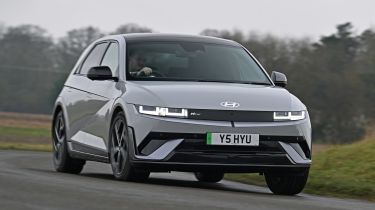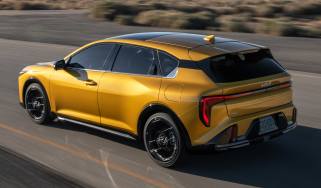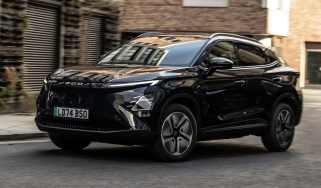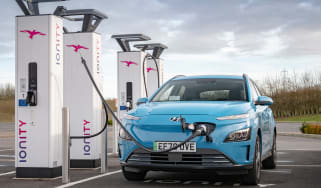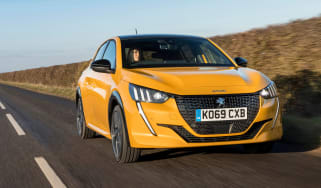Hyundai Ioniq 5 review – Electric motor, drive & performance
"Brisk acceleration and assured handling"
Like most of the current electric cars, the Ioniq 5 is heavy due to the weight of its batteries. Yet, despite weighing just under two tonnes, this mass is low down between the wheels, so the Ioniq 5 handles well, with little body lean in corners.
This is despite the fact its suspension is fairly soft and while its steering is a bit lacking in feedback, there's plenty of accuracy and a consistent feel. It's a good blend of comfort and fun, but if you're after excitement the Kia EV6 is a sharper choice that’s more rewarding to drive. It’s a gap that narrowed slightly for the updated 2025 cars, because these get slightly firmer suspension to improve handling and stability, without making it uncomfortable.
The Ioniq 5 feels wide down country lanes, but mid-corner bumps that previously upset the otherwise smooth feel are now dealt with more assuredly. Pick the N Line trim and it gets more aggressive looks and 20-inch ‘N Design’ alloy wheels inspired by the Ioniq 5 N performance model. It doesn’t get the same suspension, big brakes or artificial gearchanges of the full-fat N model though, so it’s really aimed at those who love the style of the N, but still need a comfortable cruiser.
More reviews
Some of the other changes for 2025 have led to an improved driving experience. The brand added strengthened structural components to reduce vibration through the steering wheel.The Ioniq 5 has always been a quiet car, but Hyundai even added more sound insulation around the rear electric motor to make it even more refined. Hyundai even added a rear washer and wiper system which it didn’t have before, meaning rearward visibility is also improved on rainy or grimy days.
Hyundai Ioniq 5 electric motor
Entry versions of the 5 are fitted with a 168bhp motor driving the rear wheels. This gives it a respectable 0-62mph acceleration time of 8.5 seconds, which is on a par with many petrol and diesel crossovers and matches the 201bhp Volkswagen ID.4.
The next rung up the Ioniq 5 ladder brings a power increase to 225bhp, taking around a second off the acceleration benchmark. This motor feels quick enough for most drivers and can even cause the rear wheels to spin if you press on the accelerator pedal hard enough. Full power is released in Sport mode, which you can select with a quick toggle of the dial on the steering wheel.
Then there's the top version, which adds a second front motor, increasing its combined power to 321bhp with a mighty 605Nm of torque – almost double that of the entry version. Performance is significantly better, with 0-62mph taking a hot hatch-rivalling 5.3 seconds. This makes it similarly powerful as the 335bhp ID.4 GTX and a tenth quicker to 62mph from a standing start. You only really notice this extra performance if you really accelerate hard, so in most situations the dual-motor setup doesn't offer a big advantage, but it does provide safe overtaking punch at all times.
The range-topper feels remarkably smooth until you press the accelerator pedal into the floor. The only upset comes from the 20-inch alloy wheels, which can cause the ride to become unsettled on poorly surfaced roads. Luckily, the soft seats also help absorb any sharp impacts transmitted into the car.
Keen drivers will gravitate towards the Hyundai Ioniq 5 N performance model, which follows on from the i20 N, i30 N and Kona N and is the brand’s first electric model to wear the 'N' nameplate. This is one of the best EVs to drive at any price, and we’ve reviewed the Ioniq 5 N in full separately.

